Exploring the Eloquent Avian Communicators: Birds That Talk
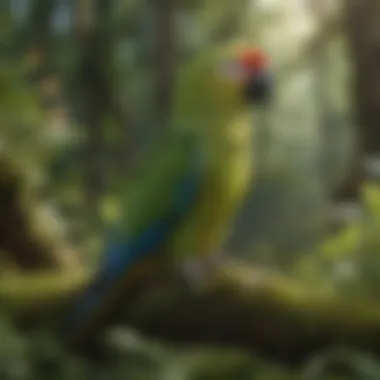

Intro
The ability of birds to communicate with humans and each other has long fascinated bird enthusiasts and scientists alike. This article provides insights into avian vocalization, specifically focusing on what makes certain birds exceptional talkers. Understanding why some birds mimic sounds brilliantly can enhance the experience of owning a pet bird. Different species exhibit unique vocal capabilities that stem from both their biology and environment.
In this exploration, we will discuss key species known for effective communication skills, the roles of mimicry and natural instinct in vocalization, and offer practical advice for improving communication with pet birds.
Care Tips
Integrating responsive communication with proper care enhances the relationship between the bird and owner. Tailoring daily routines, creating positive environments, and ensuring health is paramount for birds that thrive in congenial settings. Here are several vital areas of focus:
Daily Care Routines
Routine is essential for a pet bird. Schedule interactions to promote vocalization and develop trust. Include time for social engagement, which can encourage them to talk. Observing their habits organizes your daily care tasks effectively.
Cage Setup and Maintenance
A suitable cage setup is more than just a home. It is a sanctuary for avian companions. Provide enough space to exercise, with varied perches and toys that stimulate their intellect. Maintain cleanliness meticulously.
Hygiene and Cleaning Practices
Hygiene is vital for bird health and, indirectly, their ability to communicate. Regular cage cleaning prevents illness and fosters an enriching environment. This provides the motivation for effective sound production.
Seasonal Care Adjustments
Birds may react sensitively to seasons. During colder months, ensure they have warmth. In summer, be careful about excessive heat. Adjust their surroundings continuously to guarantee a comfortable living space.
Behavioral Insights
Creating a connection through vocalization requires understanding their behavior. Being aware of body language and behavioral trends can inform your approach to communication.
Understanding Bird Body Language
Birds often communicate non-verbally. Understanding these cues enables owners to interpret the needs and emotions of their birds. Recognizing when they are happy or anxious will enhance engagements.
Common Behavioral Issues and Solutions
Distress can cause chattering to cease. Understand common issues like biting, excessive noise, or withdrawal. Address these proactively to encourage a comfortable environment that fosters conversation.
Positive Reinforcement Techniques
Encouragement and effective communication often come together. Use treats or praises when birds mimic sounds or engage in interaction. Positive feedback forms a rewarding loop that strengthens their talking habits.
Social Interaction Needs
Birds are inherently social creatures. Regular interaction fuels their desire to learn and communicate. Adequate attention prevents boredom and encourages vocal expression, enriching their lives.
Nutrition Guides
Overall health directly influences a bird's communication skills. A balanced diet supports cognitive functions associated with vocal mimicry. Here’s a general breakdown:
Essential Diet Components
Focus on a diverse diet. Fresh fruits, vegetables, high-qality seeds, and formulated pellets should be main parts.
Safe and Toxic Foods
Gather knowledge regarding essential species-specific dietary needs as well as foods that are toxic to avians. Familiarity shields pets from dietary-related health issues.
Supplements and Treats
Occasional treats can motivate communication. Whether it is healthy snacks like specific fruits or formulated treats, do be aware of proper quantities.
Feeding Strategies for Different Species
Tailor feeding based on your bird type. Research varying counter-intuitive dietary needs by species provides clarity. Tools like the A.F.B.A. guide from Britannica can assist.
Wellness and Health
Maintaining the võll-being of your pet is crucial. Regular vet checkups and knowledge of common symptoms can prevent more serious problems over time. Discuss preventative care with your vet for individual needs.
Routine Health Checkups
Regular visits to a vet ensure vocal and physical health. Early detection gives the birds better long-term outcomes and keeps their communication channels open.
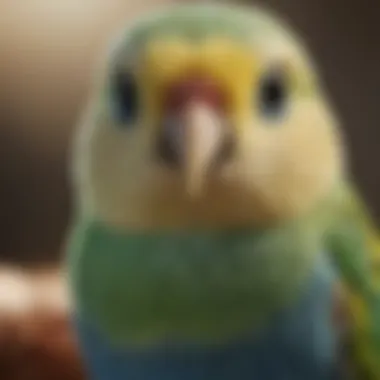
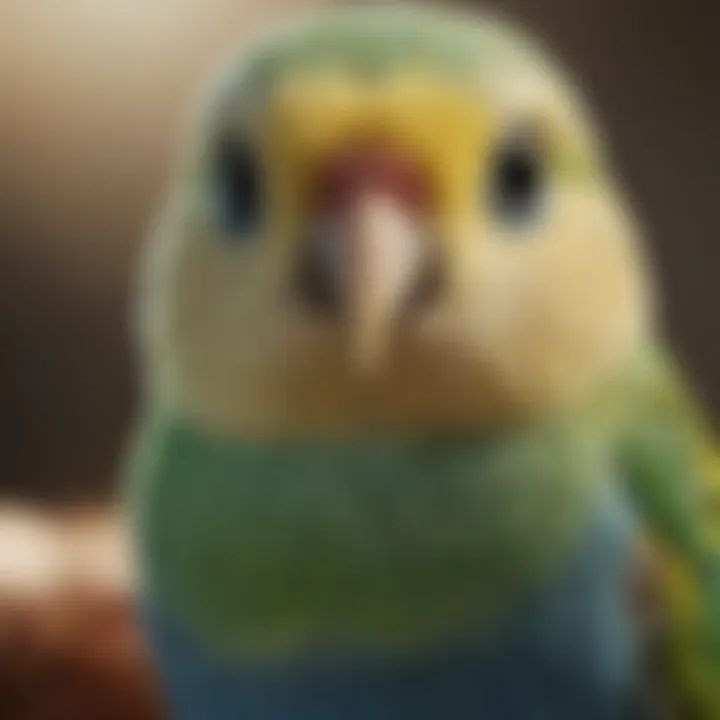
Identifying Symptoms of Illness
The sooner an illness is determined, the better while the treatment is folllowed seamlessly. Excessive sleeping or harsh vocalizations are often primary warning signals.
Preventative Care and Vaccinations
Preventative measures can help jazz suliaxrian styplions. O_免费 Discuss vaccinations, practices six-uoptional oping your birds from common diseases proposes. Make sure you meet health standardss.
Mental and Emotional Well-being
A thriving mental state contributes significantly to a bird reaching its vocal potential. Recognize indicators of stress or boredom, as they will curtail communication efforts. Use enrichment strategies mentioned in previous sections to help maintain a healthy mind.
Enriching Activities
Keeping a talking pet engaged goes far beoynd nutrition or hygiene. Here ar Open boundaries wet enhances masury talking abilities ofունenvelop prosing activities worth considering:
Toys and Playtime Ideas
Equip birds with various toys that challenge their intellect. Simple yet thoughtful play can foster mimicry every time they explore new selections.
Training and Tricks
Teaching pet birds basic tricks not only bonds the bird-huser relationship but also encourages definite sounding actions. Regular sessions empower growth.
Outdoor Activities and Interaction
Outside, lave fair lighter stimulating stimuli bluetooth memory in enhancing engagement aad violin the talkative tendencies ssfllies lyereniquence speech.
DIY Projects for Mental Stimulation
Engaging in handcrafted fun allows owiing utilization and intellectual exercise campaigns. Consider bird-safe projects that encourage convolutioninches langer engagements.
In Summary: Embracing shared communication in your feathered friends existence involves complex interlays of factors ranging from perks to bird's breathing grounds positively specify wellness pathways on socielisse yendo at meant inspired communical effects to domainine their train journey!
Prelims to Avian Vocalization
Avian vocalization represents a complex dimension in the study of bird behavior. It incorporates multiple cellular mechanisms in the species capable of producing human-like sounds. For many bird enthusiasts, understanding how these creatures communicate enriches the overall experience of caring for pet birds. This section establishes the foundational concepts that underscore the communications skills among avian species. Knowing the details helps owners appreciate the nuances in how their birds interact with them.
The Importance of Communication in Birds
Communication plays a vital role in the life of birds. It allows them to convey essential messages, such as alerts for potential threats, availability of food, or defining territory. The ability to communicate has evolutionarily developed due to the benefits it provides in social structures within species.
- Alert Systems: Birds use calls that warn others of predators. This vocal alert helps promote survival.
- Social Bonding: Active communication fosters bonds between birds in flocks. This can enhance mating rituals and mating pairs.
- Territorial Claims: Vocalizations signal ownership of territory. This practice minimizes conflicts between neighboring birds and assures a local resource.
Understanding these aspects enhances one’s appreciation of their pet birds. It also encourages bird owners to engage more, thus improving the birds' mental well-being.
Understanding Bird Anatomy and Vocalization
Understanding bird anatomy is essential to comprehend their vocal abilities. Birds possess a specialized vocal organ called the syrinx, which situated at the junction of the trachea and bronchi. The structure of the syrinx allows for a range of sounds, from simple calls to complex mimics.
The anatomy breaks down distinct elements, such as:
- Syrinx: The primary vocal apparatus, key for sound modulation.
- Respiratory System: Supports vocalizations by providing airflow, crucial for sound production.
- Facial Musculature: Plays a role in the vocalization position and resonance experience.
Each factor contributes to a bird's vocal repertoire. Birds in more social environments tend to develop extensive vocal traditions, showcasing their ability to relate well with humans and other avian species. Recognition of these structures gives insight into better communication methods between pets and their owners.
Species Renowned for Their Talking Abilities
Understanding the species known for their talking abilities illuminates fascination surrounding avian vocalization. These species are remarkable not just for their ability to mimic human speech but also for their overall communicative capacities. Numerous factors contribute to a bird's unique ability to communicate, ranging from genetics to social interactions and training methods.
Birds that excel in mimicry and vocalizations add a special bond between them and human companions. This unit of communication helps enhance relationships, enrich lives, and ensure a fulfilling experience for pet bird owners. Therefore, exploring these species' characteristics is invaluable for avian enthusiasts aiming to understand their feathered friends better and create an environment conducive to vocal expression.
African Grey Parrots
Vocal Intelligence
African Grey Parrots showcase significant vocal intelligence. They are widely recognized for their impressive cognitive abilities, making them some of the highest-ranking talking birds. Their naural aptitude for learning can lead to a vocabulary of hundreds of treasured words and phrases. Commonly regarded as one of the poster birds for avian language, their intelligence stands out when observing their capability to engage with humans using unique dialogue.
This comparative intelligence leads to some of the most talked about aspects of avian behavior studies.
Contextual Speech
Another captivating attribute of African Grey Parrots is their proficiency in contextual speech. They often display the ability to use words meaningfully, rather than simply mimicking phrases they hear. Their ability to apply learned sounds to relevant situations indicates a neural complexity akin to that found in young children. Recognizing the tone and intent behind speech makes African Grey Parrots celebrated companions for many bird lovers.

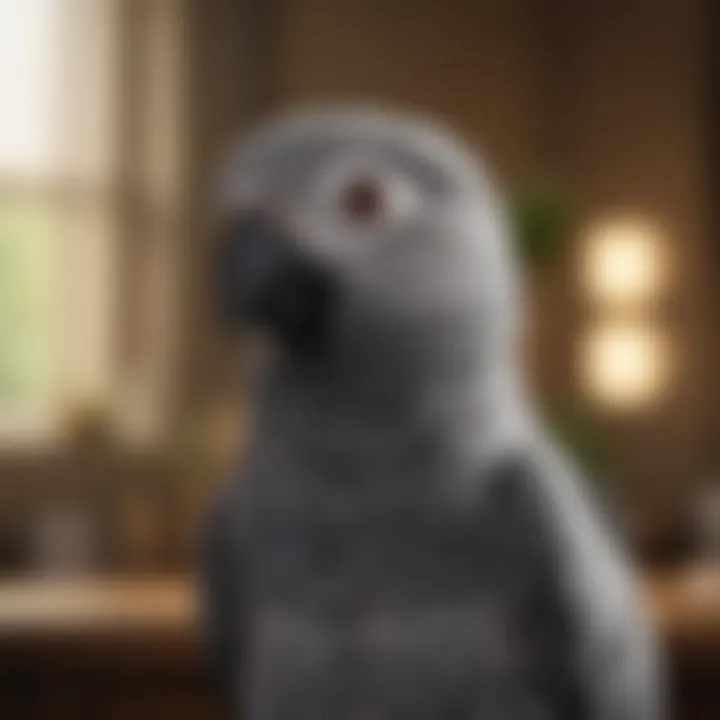
This unique feature allows pet owners to enrich their interactions with contextual understanding.
Amazon Parrots
Distinct Dialects
Amazon Parrots introduce the concept of distinct dialects. These birds exhibit differences in vocalization patterns based on geography and social structures. Not only does this demonstrate their adaptability, but it also signifies that communication within their community varies by region. Such diversity in dialect generates broad interest in understanding animal communication connotations. It sparks worldwide enthusiasm among scholars and bird enthusiasts who hope to glean insight into language development.
Interactive Nature
Another of Amazon Parrot's selling points lies in their interactive nature. These birds are incredibly social and responsive. They often engage in behaviors that can elicit a response from their human caretakers. This proves very fruitful for nurturing a bond that focuses on vocal engagement. Their lively nature fosters environments for imitative behaviors, making them standout choices for those interested in incorporating talking abilities.
Yellow-naped Amazon
Learning Capacity
The Yellow-naped Amazon displays striking learning capacity. Given proper exposure, these birds have a keen ability to learn and retain words often becoming articulate communicators. Their high aptitude provides potential for owners looking to foster an environment for enriched avian speech. Notably, their eagerness to engage mentally signifies a rewarding partnership between the birds and their owners.
Popular Phrases
Ilitating the dedication of Yellow-naped Amazons down to their popular phrases makes it easier for owners to appreciate every relationship. Many of these birds can be trained to recite specific phrases or greetings. This feature not only impacts the living home atmosphere, but also encourages conversations that bring joy to family gatherings.
Budgerigars (Budgies)
Social Learning
Budgerigars display exceptional social learning capabilities. They intuitively mirror phrases within their social circles, providing beneficial experiences for both owners and birds. Given the vivid environment these birds thrive in, social learning encourages a bi-directional interaction that results in verbal mimicry. This capacity makes Budgerigars favored pets, especially among families. Their willingness to learn represents endless opportunities for verbal fancy and experimentation.
Phrase Repetition
Perhaps one of the most amusing aspects of Budgerigars is their talent for phrase repetition. The charm of these petite birds is greatly amplified by their effortless mimicry. This unique trait transforms a simple interaction into personable exchanges that can deeply resonate with owners.Teachable simplicity fosters enjoyment that both parties can celebrate.
Eclectus Parrots
Voice Modulation
Eclectus Parrots are well known for their remarkable voice modulation skills. Their capability to adjust pitch and tone stands out, as this modulation significantly enhances their communications. This characteristic not only reflects their adaptability in various environments but also allows for deeper connections with owners who can reciprocate vocal play. Moderate pronunciation adds uplifting dynamics to conversations.
Affectionate Mimicry
Another lovely feature of Eclectus Parrots is affectionate mimicry. They often imitate tones associated with the emotions they observe. Such engaging behaviors foster a daily connection that resonates on emotional levels in households, deeming these parakeets well-liked snippets among pet lovers.
Cockatoos
Emotional Expression
Cockatoos are celebrated for their strong emotional expression through vocalizations. Many variations arise based on bonding experiences, leading breed enthusiasts to take active engagement seriously. For families, this means gaining songs and responses that resonate on prominent emotional levels. Observing and engaging with a Cockatoo moderation allow for enriching environments that positively reinforce shared love.
Vocal Playfulness
On top of emotional nuances, Cockatoos are the embodiment of vocal playfulness. Frequent experimentation with tones brings an joy observers seek. Pet owners often recount hilarious anecdotes centered on vocal improvisation, providing further excuse to share playful like-exclamations. This playful demeanor is vital in maintaining satisfying partnerships, accentuating the need to foster creative vocal gestures.
Factors Influencing Talking Ability
The ability of birds to vocalize intelligently is influenced by various factors. This section covers elements such as genetics, environment, and training techniques that contribute to a bird's speaking skills. Understanding these factors is essential for pet bird owners or aspiring bird parents who wish to enhance the communication capacity of their avian companions. Recognizing that it is a combination of nature and nurture allows for targeted approaches in fostering successful speaking abilities.
Genetics and Breed Specifics
Genetics play a crucial role in a bird's potential for vocalization. Certain breeds are more predisposed to mimicry than others. For instance, the African Grey Parrot is highly regarded for its vocal talents. This parrot can simulate human speech and represents a perfect example of how genetics influence vocal capabilities. Additionally, other species, like Amazon and Eclectus parrots, also show high talking potential due to similar genetic predispositions.
Before adding a talking bird to your family, it is wise to research breed-specific traits. Some breeds may require more attention and specific conditions to reach their vocal potential. In striving for a talkative companion, potential bird owners should weigh breed traits against various responsibilities involved.
Environment and Socialization
The environment in which a bird lives can significantly impact its communication skills. Birds are social animals. A stimulating and interactive setting maximizes the chances of developing their vocal potential. Engaging with a bird regularly is essential. Time spent talking, playing, and providing interaction leads to a stronger relationship between owner and bird. This connection encourages the bird to attempt vocalizations, as they closely associate the human voice with social interaction.
Socialization also includes exposing birds to various sounds and auditory experiences. Birds usually mimic surrounding noises as a way to communicate. Consequently, allowing them to hear human speech often sets the right foundation for mimicry. Creating a diverse auditory environment is quite beneficial as well.
Training Techniques for Enhanced Speaking Skills
Training is another indispensable factor affecting a bird's talking ability. Behavioral training methods increase vocal fascination and encourage mimicry. Techniques such as positive reinforcement can boost the speed of learning in birds. By rewarding them with treats or praise for speaking, owners can emphasize vocal behaviors they wish to reinforce.
In addition, utilizing repetition is an effective training technique. Consistently speaking specific phrases at various times can aide in a bird grasping particular words or sounds. A common suggestion is to engage in short vocal exercises with the bird on a daily basis. Doing so helps solidify understanding over time.
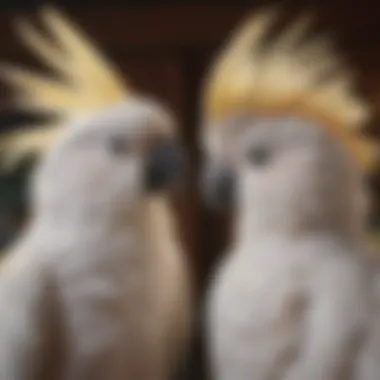
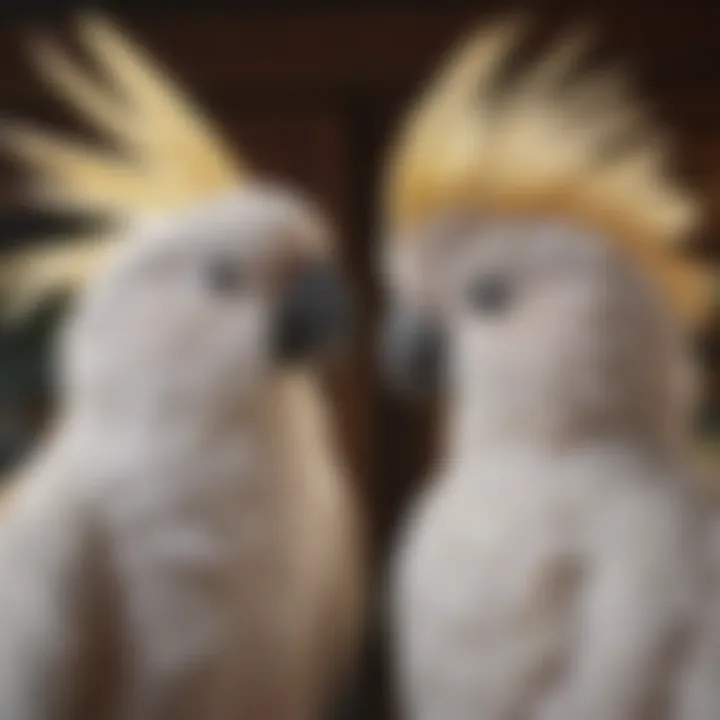
Utilizing effective training strategies can combine well with insights about genetics and environment. The outcome can greatly enhance the communication capabilities of pet birds, molding them into more talkative companions. Incorporating those elements ensures a richer and rewarding experience for birds and owners alike.
Care Considerations for Talkative Birds
Caring for talkative birds is a crucial responsibility for pet owners and bird enthusiasts. These birds, known for their vocal capabilities, require specific care to thrive in domestic environments. Proper care not only supports their well-being but also enhances their inclination to communicate. Especially for species renowned for their talking talents, attention to details in care can significantly influence their ability to vocalize.
Nutritional Requirements
Nutritional health is vital for the vocal health of birds. Understanding proper diet is the first step in this care. Birds should have a well-balanced diet that includes fresh fruits, vegetables, seeds, and pellets tailored to their species. The right nutrients ensure optimal bodily function, directly impacting vocalization. Avoid processed foods and excessive seeds high in fat, as these can lead to health problems.
A focus on how these vitamins and minerals contribute to range and clarity in speech can enhance a bird's communicative potential:
- Vitamins A and D: Essential for maintaining feather quality and skin health.
- Calcium: Supports bone structure essential for sound production.
- Protein: Needed for overall strength and vigor.
Ensuring birds receive recommended varieties of food aids in their health and thus, their talking abilities. Providing clean, fresh water daily is also niacessary for their overall stomach health.
Creating an Enriching Environment
The environment birds live in has significant effects on their vocalization and mental states. An enriching atmosphere fosters curiosity and learning, which can lead to enhanced mimicking skills. Consider incorporating components into their living spaces:
- Perches and Towards: Security as bird will simply enjoy being higher up.
- Toys and Puzzle Feeders: Keep birds engaged mentally; boredom can lead to less vocal expression.
- Other Birds: If compatible, pairing them can establish social learning opportunities.
Adding variety while ensuring safety are further points when decorating their space. Sounds from the environment, like music or nature sounds, can stimulate conversation as well, engaging the birds in their vocal interest in nature sounds's feeling.
Regular Veterinary Care
Elevating care practices to regular veterinary visits cannot be overstated. Birds often hide signs of illness effectively, making preventative care necessary. An avian vet provides insights into optimal feeding, diagnostic check-ups, and vaccinations to maintain health. Healthcare attention should include:
- Routine Health Screenings: Early detection is critical for illness intervention.
- Grooming Practices: Regular monitoring can help to diagnose issues that might affect vocalization, such as inappropriate beak or feather[y] health issues.
- Behavioral Assessments: Discussion with a veterinarian can adjust treatments to any changes in behavior and far more importantly conversing nature dependence.
Accessing experienced avian vet can bolster ability to interact and elevate talking education in pet birds. The link between health and communication is clear, offering an indoor ecosystem that supports and brings forward their typical vocal habits.
An avian vet's support allows layman to secure multifaceted veterinary care essential for the growth of these brilliant creatures.
Enhancing Communication with Your Pet Bird
Developing a strong communicative bond with your pet bird can be immensely rewarding. This section underscores the importance of fostering effective communication through various strategies. By enhancing these skills, pet parents can not only deepen their relationship with their birds but also support the birds' mental well-being. Interacting with birds is not merely an option but a necessity, aiding their emotional health and boosting their intelligence.
First, daily engagement determines the quality of interaction. Birds are social creatures, and the time spent doing activities together fosters trust and bonding. Building routines around interaction strategies also creates a sense of safety and familiarity. Essentially, these exchanges lay the groundwork for richer communication and understanding.
Daily Interaction Strategies
Daily interactions serve as the foundation for your bird's ability to communicate effectively. Establishing consistent routines of conversation encourages your birds to practice their vocal skills. Here are a few methods to incorporate:
- Scheduled Talking Sessions: Set aside specific times each day to speak with your bird. Use simple vocabulary and encourage your pet to respond.
- Mirror Techniques: Place a mirror near their cage, allowing them to observe and replicate sounds whilst watching their reflection, a natural source of curiosity.
- Subtle Gesture Communication: Employ hand signals or gestures alongside your verbal language. Birds tend to respond well to non-verbal cues. This collaboration promotes comprehension alongside auditory skills.
Make interaction an engaging experience every day for ongoing development.
Using Positive Reinforcement
Positive reinforcement is crucial in persuading your bird to express itself. Employing this strategy encourages pets to repeat desirable behaviors and vocalizations. Here are elements of effective positive reinforcement:
- Treats as Incentives: Provide small, healthy treats following successful mimicking or vocal repetition.
- Verbal Praise: Offer vocal affirmations like “good job!” in an enthusiastic tone to reinforce positive outcomes.
- Timely Rewards: Ensure that reinforcement occurs immediately after desired behavior. This helps the bird connect actions with rewards faster.
By systematically implementing these practices, you encourage a more responsive and talkative companion through consistent, positive exchanges.
Incorporating Play into Learning
Play is central to learning for birds. Engaging your pet in enjoyable activities stimulates their cognitive processes and enhances their capacity for communication. Consider amalgamating learning with play by:
- Interactive Toys: Choose toys that prompt vocal interaction, such as those that play recordings or respond to your bird's chatter.
- Music and Sounds: Introduce playful sounds or music into the environment. Birds enjoy rhythms and may try to mimic interesting sounds they find appealing.
- Teach through Games: Create games that promote learning with commands or words. Simple word associations can be integrated naturally into play.
In summary, enriching a pet bird’s learning environment through play results in improved communication skills while creating enjoyable pastimes that both you and your bird can appreciate.
Engaging your pet bird with daily strategies, effective reinforcement, and playful colorful interactions can significantly enhance the bond you share while also refining their vocal opportunities.
Culmination
Summarizing the Importance of Communication in Birds
Communication is an essential aspect of avian life. Birds express their needs, establish relationships, and navigate their environments through vocalization. For pet birds, being able to mimic human speech significantly enhances their emotional and social relationships with their owners. This ability empowers birds by enabling them to share experiences and create interactive environments where they can thrive. Moreover, understanding their way of signifying emotions, needs, and ideas adds a unique layer of connection between birds and humans.
Birds like African Grey Parrots and Cockatoos are prime examples of how avian communication extends beyond mimicry. These species showcase complex vocal behaviors as a means of social bonding and emotional expression. Creating an enriched environment with opportunities for social interaction offers substantial benefits for the wellbeing of these creatures.
Looking Toward Future Research
As our understanding of avian vocalization grows, numerous avenues remain for future exploration. For instance, researchers may further investigate the cognitive pathways involved in speech acquisition among various species. Insight into these aspects would effectively expand the body of knowledge surrounding communication and intelligence in birds. Understanding how environment and genetics influence vocal abilities could lead to impactful changes in breeding practices and nurturance of pets.
Additionally, specific communities, forums like reddit.com as well as organizations like wikipedia may have vital contributions to ongoing public discussions surrounding avian communication.
Notably, comparative studies among diverse bird species, such as the differences between Psittacidae (parrots) and Corvidae (crows), can unveil unique adaptive functions tied to their vocal behaviors. As such research seems promising for enhancing bird welfare in captivity, spanning multiple regions on subjects of ecological impact and behavior modification, it ultimately serves as a heartfelt reminder of the critical relationship we share with our feathered companions.















